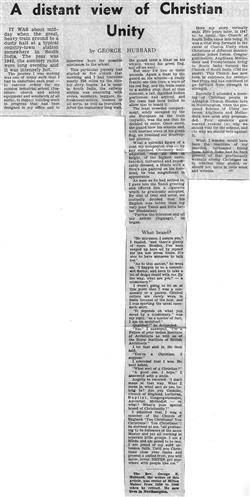A distant view of Christian Unity
[In 1969 George writes to the Northampton Chronicle and Echo, the local paper.]
South India
IT WAS about midday when the great, heavy train ground to a dusty halt at a typical country-town station somewhere in South India. The year was 1942, the summer rains were long overdue, and it was intensely hot.
The journey I was making was one of many such that I had to undertake each year - to canvass orders for my mission industrial school (furniture, church and school equipment and woodwork of all sorts), to inspect building work in progress that had been designed in my office and to interview boys for possible admission to the school.
This particular journey had started at five o'clock that morning and I had travelled nearly 250 miles by the time my story begins. As is usual in South India, the railway station was swarming with crows, monkeys, beggars, refreshment-sellers, traders of all sorts, as well as travellers. After the customary long wait, the guard blew a blast on his whistle, waved his green flag, and off we went.
But only for two or three seconds. Again, a blast by the guard on his whistle - a really frantic one this time, a wave of his red flag, and the train came to a sudden stop. Just at that moment, a tall, dignified Indian gentleman had arrived, and the train had been halted to allow him to board it.
The least crowded compartment, solely occupied by the one European on the train (myself), was the one that he decided to enter. Once more, the guard blew his whistle and, with another wave of his green flag, we resumed our interrupted journey.
What a splendid figure of a man my companion was - by any standard. Obviously well-educated, over six feet in height, of the highest caste, bearded, turbaned and impeccably dressed, a Hindu with a Siva's eye painted on his forehead, he was magnificent in appearance.
As soon as he had settled in, I gave him the Tamil greeting and offered him a cigarette which he graciously accepted. By dint of trial and error, we mutually decided that his English was better than my very poor Tamil and little better Hindustani.
"Pardon the intrusion and all my saman (luggage)," he began.
What brand?
"No intrusion, I assure you," I replied, "and there's plenty of room. Besides, I've been cooped up here all by myself for the last seven hours. It's nice to have someone to talk too."
"As to this saman," he went on, "I happen to be a consultant doctor, and have to take a lot of drugs round with me. By the way, what are you? - a missionary?"
I wasn't going to let an at this point that I was a missionary or a parson. Clerical collars are rarely worn in India because of the heat, and I was sporting the usual open-neck shirt.
"It depends on what you mean by a missionary," was my reply, "as a matter of fact, I am an architect."
"Qualified?" he demanded.
"Yes," I answered, “I'm a Fellow of your Indian Institute of Architects as well as of the Royal Institute of British Architects."
I let that sink in.
He then said, "You're a Christian, I suppose."
I conceded that I was.
He next asked, "What sort of a Christian?"
"A good one. I hope," I answered with a smile.
Angrily he retorted: "I don't mean in that way. What I mean is, what sect do you belong to? Are you Catholic, Church of England, Lutheran, Baptist, Congregationalist, Adventist, Methodist - or what? What's your special brand of Christianity?"
I admitted that I was a member of the Church of England. "You Christians! You Christians!! You Christians!!! he stormed at me, "all professing to be followers of the same Master and yet all working in separate little groups. I am a Hindu and am proud to be one, I am proud of my solid un-broken faith. Until you Christians close your ranks and present a united front, you will never, never, NEVER get anywhere with people like me."
Here my story virtually ends. Five years later, in 1947 to be exact, the Church of South India came into being. It was a vital step forward in the cause of Church Unity when Christians of different denominations joined forces. Congregationalists, Anglicans, Methodists, and Presbyterians living in South India formed the Church of South India (CSI for short). This Church has now been in existence for twenty-two years and has continued to go forward from strength to strength.
Recently I attended a meeting of Christian people in Abington Church Rooms, here in Northampton, when the proposed Scheme of Unity between Anglicans and Methodists was most ably propounded. Four speakers gave learned reasons (a) why we should vote for the scheme, and (b) why we should vote against it.
What, I wonder, would have been the reactions of my bearded, turbaned friend from South India had he been present at that gentlemanly wrangle among Christians as to whether they should, or should not, unite in their work and witness.
The Rev. George E. Hubbard, the writer of this article, was rector of Milton Malsor from 1959 to 1966 when he retired.
He now lives in Northampton.
